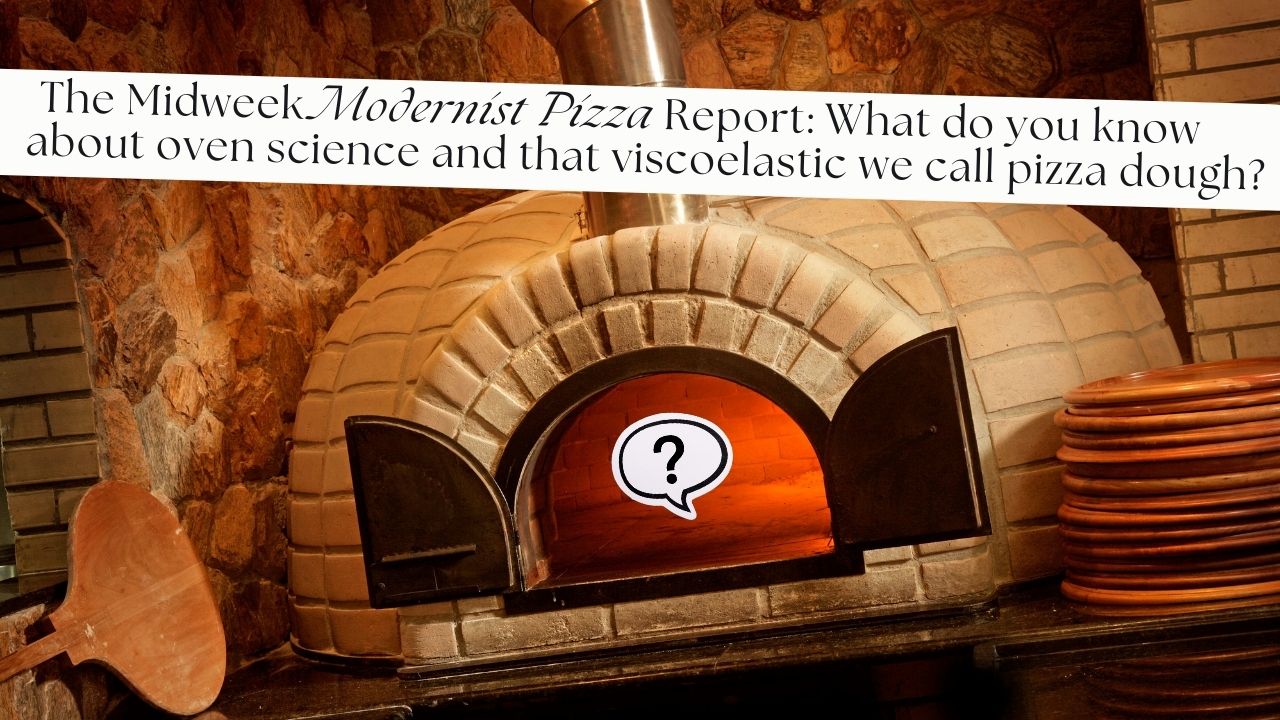The Ongoing Modernist Pizza Review, Volume 1, Chapter 5, "Pizza Ovens" (Part I)Modernist Pizza Written by Nathan Myhrvold and Francisco Migoya Published by The Cooking Lab; First edition, October 19, 2021 Hardcover: 1708 pages, 32.7 pounds, 13.78 x 10.24 x 15.94 inches List Price: $425.00 Amazon discount price as of 03/08/23: $294.99 Last time, we reviewed Modernist Pizza’s pulling back of the curtain on mysteries related to dough ingredients. Today, we’re going to look at how their discussion of my personal favorite topic: The Pizza Oven! The Modernistas give pizzaioli a lot of credit. They begin the oven section by discussing how intuition matters and must be honed. They tell us that most bakers understand instinctively that baking is an art form, but it is also a process that is physical, chemical and biological. Presumably, they’re speaking more of pros than amateurs. Speaking as an amateur, I know that it’s easy for us to get out of our depth on pizza making and think we still know what we’re talking about. And that certainly extends to amateur oven knowledge. ABOUT THOSE PIZZA OVENS...
Maybe you've noticed there’s a high level of amateur arrogance out there. It would be assuaged by those same amateurs reading Modernist Pizza in its entirety. They’d then know how much they don’t know. But that’s also asking a whole lot. And social media has never been about depth of knowledge as much as the volume level. Being scientists, the Modernistas are obviously scientific about their analysis. They start with a simple yet scientific premise. The contend that the real conversation, when pizza bakers are talking about the finer points of pizza, is about this: Energy alters food. Understanding basic physics and fundamentals of heat transfer “can greatly reduce failures and frustrations.” They also know from whence they speak. Apparently, the techniques in Modernist Pizza are pushing the limits of refinement “by trial and error.” But again, they’re not always talking about amateurs here. For instance, it seems unlikely they’d be saying this to a casual home pizzamaker: “If you’re serious about making good pizza, an oven should be among your biggest investments (followed by temperature control and then a walk-in refrigerator).” Fortunately, they also recognize that some of us are merely “enthusiasts.” We are not going to outfit our kitchens like pizzerias. That would be foolish. It’s daunting enough just plunking down the cover price of this book. (Not that I’m sorry to have spent it. Oh, no. On the contrary, I’m not even halfway through, and already it has been an education worth far more than the cover price.) They also get into one of my personal favorite concepts about cooking. That’s because I’ve lived the repercussions of it. They get into the physics of oven heat, and how heat is really just the speed at which molecules are bumping into each other. I lived this by moving from sea level to 8,000 feet elevation, which impacted everything from pizza to barbecue. Since there are fewer air molecules to bump into each other at speed up so high, things change. Low and slow barbecue takes much longer. And pizza can explode. (It’s a yeast thing. The bubbles become huge.) Physicists talk about "reversible and irreversible reactions." I’m not a physicist. You probably aren’t either. But when we cook, we’re applying those reactions to making changes in food. For instance: When protein molecules stick together or break apart. Sounds a little like a soap opera. But as per Modernist Pizza, it’s a significant part of pizza making. In this sport we’ve chosen, molecules both stick together and break apart during cooking. This is about gelling the starch in the dough. This holds the gluten network together, creating bubbles that trap gas. The gelled starch holds bubbles together and forms a stable crust structure. Additionally, there are differences between radiant heat and conductive heat. We get a basic discussion of heat flow, and a quick lesson in conduction vs. convection. (By the way, all ovens are convective. What’s special in a so-called “convection oven” is that you put a fan inside of it, thereby creating “forced convection.” The devil is in the details.) We also get to dabble in thermal diffusivity. This is apparently what we often mistake for conduction. That’s because more conductive materials are more thermally diffusive. And here’s a little tidbit: Did you know a lot of heat is given off by light that we can’t see? Color me radiantly gobsmacked (but you might not be able to see the color). Makes sense, though. You might go "Ah-ha!", as we’re going to talk about charcoal grilling in a moment. Tidbits abound here. For instance, you're probably not surprised to learn that shiny materials reflect heat. The Modernistas did an experiment where they put a shiny, stainless-steel plate on the inside of the door of a deck oven. It lowered the baking time for a Neapolitan pizza from 2.5 minutes to 1.5 minutes. The pizza also baked evenly without turning it. (Are you listening, oven makers?) Experiments in this chapter abound. They did experiments with the heating properties of “clean” vs. “dirty” wood-fired ovens. They performed experiments with cookware and the heat emission of shiny vs. black pans. And let’s not forget the physics of a wood oven. As you may have already guessed, in a wood oven, “Pizza doesn’t see flame when it’s baking; it sees the indirect result of the oven surface being hot. This is well known to people who make gas grills. Gas grills also cause indirect heat by heating metal screens or plates with gas flame.” Black surfaces absorb more heat, but also radiate it away. A clean over floor gets much hotter than a black oven floor. “The physics of heat in wood-fired and has-fired pizza ovens” is a sub section here. Did you know the flame has little to do with heat? It creates light, but has little to do with radiation for heat transfer. (There’s that “light we can’t see” MO in action.) And in a wood-fired oven, the embers are the primary heat source. I'm guessing that for anyone who understands how to use a charcoal grill, this shouldn’t seem very surprising. We never start cooking until the flames have abated, and the coals have ashed over. We can't see the light, but those coals are now at their hottest. You may have noticed that high heat is an obsession amongst pizza “enthusiasts.” So it’s an interesting note when Modernist Pizza tells us this: The flame in a gas oven is hotter than the flame in a wood oven—and it also doesn’t matter. The heat that bakes the pizza is radiant. The absorbed heat in the floor and walls of the oven are what bake the pizza. Speaking as an owner of various ovens over 20 years, my position is that wood is a hassle. And now learning that gas gets hotter than wood, I’m again asking: Why are we so obsessed with wood fire? (The Freudian explanation for men and controlling fire notwithstanding.) The Modernistas also performed experiments with radiative shielding. They made a mirrored shield for covering parts of a pizza as it baked. The results were confirmed in both wood and electric ovens: Radiated heat is the heat that really matters. Without radiated heat, the baking was insufficient. There’s also some infrared thermal photography (I'm sure I have the name of the technology wrong) about where heat comes from in various types of ovens. There are two-page spreads for deck ovens, wood-fired ovens and gas ovens. Seeing the thermodynamic properties is enlightening—especially in a wood-fired dome oven. When I owned a wood-fired dome oven, people would always look at it and say, “This must keep the kitchen really warm!” Not really. I’d have to explain that an oven is about containing the heat, not expelling it. And now, I could also explain that instead of emitting hot air, cold air is being sucked in through the oven door, it’s being heated, and then it’s being expelled through the door again and out the top of the dome. Have you ever wondered about all these open-door dome ovens in Pizzaland? And why doesn’t it affect baking? It’s because the pizza bakes with radiant heat from the walls and the conductive heat from the oven floor. And now ya know! And just for a moment, I’m going to jump to the end. There’s a section on choosing a pizza oven. They discuss all kinds of oven styles, including some that you’ve probably never heard of. They list portable outdoor pizza ovens as one of the choices. Home ovens, too. They then do a very analytical breakdown of recommended ovens by the type of pizza you want to make. Can you guess which oven never appears in their recommendations? That’s right: The wildly popular outdoor pizza oven never appears, either as a recommended oven or as a compromise oven. The home oven appears over half a dozen times as a compromise oven. It’s even a recommended oven in a couple of types of pizza. I feel a little bit of vindication for my oft-stated position that the best pizza oven for the amateur is the home oven. Anyway, moving on… The next time, it will be a new year, and we'll be looking at how Modernist Pizza deals with the complex physics of pizza dough and sauce, as well as The Pizzaiolo Equation. All that next time on Free The Pizza reviews Modernist Pizza for you! Until then, Happy New Year! To see Modernist Pizza in its discounted habitat on Amazon, click here. If you've never before baked a pizza, you can find the much simpler and sillier Free The Pizza right here.
1 Comment
I find it interesting when you talk about pizzas being baked with radiant heat from the walls and using conductive heat from the oven floor when using open-door domes. I wonder if they taste different if those types of food are cooked in those appliances. So I hope to find a pizza delivery restaurant that does that to taste their creation for the first time this weekend.
Reply
Leave a Reply. |
AuthorBlaine Parker is the award-winning author of the bestselling, unusual and amusing how-to pizza book, Free The Pizza. Also known as The Pizza Geek and "Hey, Pizza Man!", Blaine is fanatical about the idea that true, pro-quality pizza can be made at home. His home. Your home. Anyone's home. After 20 years of honing his craft and making pizza in standard consumer ovens across the nation, he's sharing what he's learned with home cooks like you. Are you ready to pizza? Archives
July 2024
Categories
All
|
© Copyright 2021, 2022, 2023, 2024. All rights reserved.
As a ShareASale Affiliate and an Amazon Associate, we earn a small percentage from qualifying Amazon purchases at no additional cost to you.
When you click those links to Amazon (and a few other sites we work with), and you buy something, you are helping this website stay afloat, and you're helping us have many more glorious photographs of impressive pizza.
When you click those links to Amazon (and a few other sites we work with), and you buy something, you are helping this website stay afloat, and you're helping us have many more glorious photographs of impressive pizza.


 RSS Feed
RSS Feed